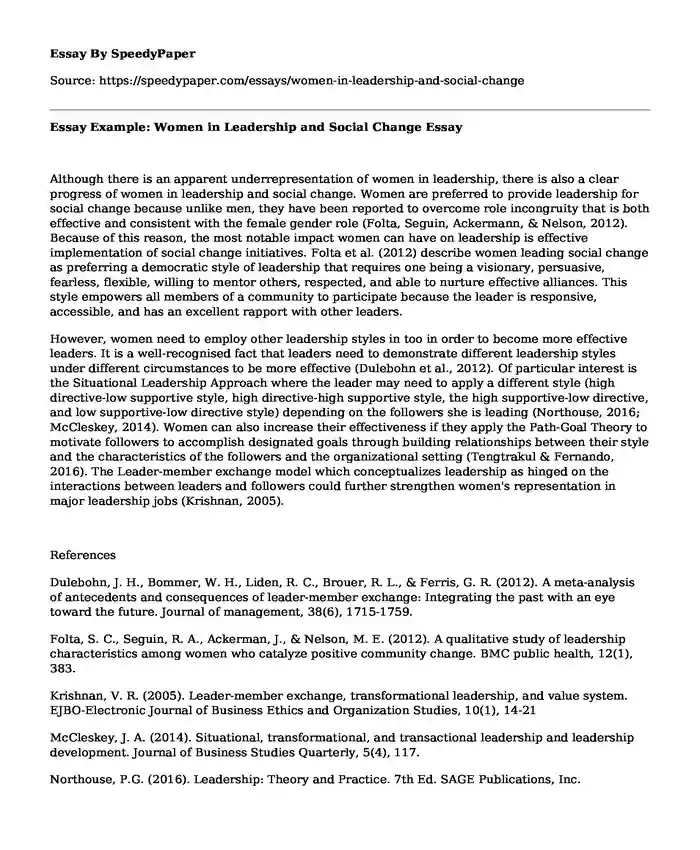
| Type of paper: | Course work |
| Categories: | Women Leadership style |
| Pages: | 2 |
| Wordcount: | 426 words |
Although there is an apparent underrepresentation of women in leadership, there is also a clear progress of women in leadership and social change. Women are preferred to provide leadership for social change because unlike men, they have been reported to overcome role incongruity that is both effective and consistent with the female gender role (Folta, Seguin, Ackermann, & Nelson, 2012). Because of this reason, the most notable impact women can have on leadership is effective implementation of social change initiatives. Folta et al. (2012) describe women leading social change as preferring a democratic style of leadership that requires one being a visionary, persuasive, fearless, flexible, willing to mentor others, respected, and able to nurture effective alliances. This style empowers all members of a community to participate because the leader is responsive, accessible, and has an excellent rapport with other leaders.
However, women need to employ other leadership styles in too in order to become more effective leaders. It is a well-recognised fact that leaders need to demonstrate different leadership styles under different circumstances to be more effective (Dulebohn et al., 2012). Of particular interest is the Situational Leadership Approach where the leader may need to apply a different style (high directive-low supportive style, high directive-high supportive style, the high supportive-low directive, and low supportive-low directive style) depending on the followers she is leading (Northouse, 2016; McCleskey, 2014). Women can also increase their effectiveness if they apply the Path-Goal Theory to motivate followers to accomplish designated goals through building relationships between their style and the characteristics of the followers and the organizational setting (Tengtrakul & Fernando, 2016). The Leader-member exchange model which conceptualizes leadership as hinged on the interactions between leaders and followers could further strengthen women's representation in major leadership jobs (Krishnan, 2005).
References
Dulebohn, J. H., Bommer, W. H., Liden, R. C., Brouer, R. L., & Ferris, G. R. (2012). A meta-analysis of antecedents and consequences of leader-member exchange: Integrating the past with an eye toward the future. Journal of management, 38(6), 1715-1759.
Folta, S. C., Seguin, R. A., Ackerman, J., & Nelson, M. E. (2012). A qualitative study of leadership characteristics among women who catalyze positive community change. BMC public health, 12(1), 383.
Krishnan, V. R. (2005). Leader-member exchange, transformational leadership, and value system. EJBO-Electronic Journal of Business Ethics and Organization Studies, 10(1), 14-21
McCleskey, J. A. (2014). Situational, transformational, and transactional leadership and leadership development. Journal of Business Studies Quarterly, 5(4), 117.
Northouse, P.G. (2016). Leadership: Theory and Practice. 7th Ed. SAGE Publications, Inc.
Tengtrakul, A., & Fernando, M. S. C. (2016). Toward High Performance Organization using Path-Goal Theory and Transformation Theories: A case Study of St. Louis School Chachoengsao.
Cite this page
Essay Example: Women in Leadership and Social Change. (2022, Sep 09). Retrieved from https://speedypaper.net/essays/women-in-leadership-and-social-change
Request Removal
If you are the original author of this essay and no longer wish to have it published on the SpeedyPaper website, please click below to request its removal:
- Free Essay Sample on Causal Relationship
- Human Trafficking: Group Need, Free Essay Example
- The History of South Beach - Tourism Essay Example
- Essay Example about Economic Simplified Boiling Water Reactor
- Free Essay with a Rhetorical Analysis of the Article How to Defeat ISIS
- Free Essay Example on Steganography
- Essay Sample on Why Millennials Are Not Getting Married
Popular categories




